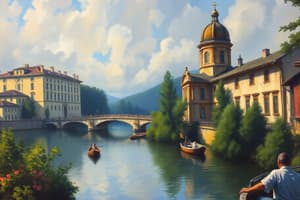Podcast
Questions and Answers
Which of the following is considered as personal property?
Which of the following is considered as personal property?
- State-owned lands
- Forces of nature brought under control by science (correct)
- Public buildings
- Roads and canals
Which type of property belongs to the State, without being for public use?
Which type of property belongs to the State, without being for public use?
- Private property
- Property of public dominion
- Real property
- Patrimonial property (correct)
What is the classification of movable property?
What is the classification of movable property?
- Consumable and non-consumable (correct)
- Real and personal
- Public and private
- Patrimonial and public dominion
What happens to property of public dominion that is no longer intended for public use?
What happens to property of public dominion that is no longer intended for public use?
What is included in property for public use in provinces, cities, and municipalities?
What is included in property for public use in provinces, cities, and municipalities?
What type of property is intended for some public service or for the development of the national wealth?
What type of property is intended for some public service or for the development of the national wealth?
What is considered as personal property according to Article 417?
What is considered as personal property according to Article 417?
What is the classification of property according to Article 419?
What is the classification of property according to Article 419?
Which of the following is considered immovable property?
Which of the following is considered immovable property?
What is considered as movable or personal property?
What is considered as movable or personal property?
What is not considered immovable property?
What is not considered immovable property?
What is considered as part of an immovable?
What is considered as part of an immovable?
What is considered as immovable property?
What is considered as immovable property?
What is not considered as part of an immovable?
What is not considered as part of an immovable?
What is considered as immovable property?
What is considered as immovable property?
What is considered as part of an immovable?
What is considered as part of an immovable?
Flashcards are hidden until you start studying
Study Notes
Classification of Property
- All things that can be owned or may be the object of appropriation are classified into two categories: immovable or real property, and movable or personal property.
Immoveable Property
- Land, buildings, roads, and constructions of all kinds adhered to the soil are considered immovable property.
- Trees, plants, and growing fruits are considered immovable property while they are attached to the land or form an integral part of an immovable.
- Everything attached to an immovable in a fixed manner, such as statues, reliefs, paintings, or other objects for use or ornamentation, are considered immovable property.
- Machinery, receptacles, instruments, or implements intended for an industry or works and attached to a building or land are considered immovable property.
- Animal houses, pigeon-houses, beehives, fish ponds, or breeding places of similar nature are considered immovable property if they are intended to be permanently attached to the land.
- Fertilizer actually used on a piece of land is considered immovable property.
- Mines, quarries, and slag dumps are considered immovable property while the matter thereof forms part of the bed, and waters either running or stagnant.
- Docks and structures that are intended to remain at a fixed place on a river, lake, or coast are considered immovable property.
- Contracts for public works, and servitudes and other real rights over immovable property are considered immovable property.
Movable Property
- Movable property includes those things that are susceptible of appropriation but are not included in the category of immovable property.
- Real property that is considered as personal property by special provision of law is considered movable property.
- Forces of nature that are brought under control by science are considered movable property.
- All things that can be transported from place to place without impairment of the real property to which they are fixed are considered movable property.
- Obligations and actions that have for their object movables or demandable sums are considered movable property.
- Shares of stock of agricultural, commercial, and industrial entities, although they may have real estate, are considered movable property.
- Movable property is either consumable or non-consumable, depending on whether it can be used in a manner appropriate to its nature without being consumed.
Property in Relation to the Person to Whom it Belongs
- Property is either of public dominion or of private ownership.
- Property of public dominion includes things intended for public use, such as roads, canals, rivers, and bridges constructed by the State.
- Property of public dominion includes things that belong to the State, without being for public use, and are intended for some public service or for the development of the national wealth.
- All other property of the State, which is not of the character stated above, is patrimonial property.
- Property of public dominion, when no longer intended for public use or for public service, shall form part of the patrimonial property of the State.
- The property of provinces, cities, and municipalities is divided into property for public use and patrimonial property.
- Property for public use in the provinces, cities, and municipalities consists of the provincial roads, city streets, and other similar property.
Studying That Suits You
Use AI to generate personalized quizzes and flashcards to suit your learning preferences.




